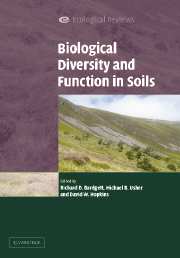Book contents
- Frontmatter
- Contents
- List of contributors
- Preface
- Acknowledgements
- PART I Introduction
- PART II The soil environment
- PART III Patterns and drivers of soil biodiversity
- PART IV Consequences of soil biodiversity
- 10 Microbial community composition and soil nitrogen cycling: is there really a connection?
- 11 Biodiversity of saprotrophic fungi in relation to their function: do fungi obey the rules?
- 12 Is diversity of mycorrhizal fungi important for ecosystem functioning?
- 13 Trophic structure and functional redundancy in soil communities
- 14 Plant–soil feedback and soil biodiversity affect the composition of plant communities
- 15 Response of the soil bacterial community to perturbation
- PART V Applications of soil biodiversity
- PART VI Conclusion
- Index
- References
14 - Plant–soil feedback and soil biodiversity affect the composition of plant communities
Published online by Cambridge University Press: 17 September 2009
- Frontmatter
- Contents
- List of contributors
- Preface
- Acknowledgements
- PART I Introduction
- PART II The soil environment
- PART III Patterns and drivers of soil biodiversity
- PART IV Consequences of soil biodiversity
- 10 Microbial community composition and soil nitrogen cycling: is there really a connection?
- 11 Biodiversity of saprotrophic fungi in relation to their function: do fungi obey the rules?
- 12 Is diversity of mycorrhizal fungi important for ecosystem functioning?
- 13 Trophic structure and functional redundancy in soil communities
- 14 Plant–soil feedback and soil biodiversity affect the composition of plant communities
- 15 Response of the soil bacterial community to perturbation
- PART V Applications of soil biodiversity
- PART VI Conclusion
- Index
- References
- Type
- Chapter
- Information
- Biological Diversity and Function in Soils , pp. 250 - 272Publisher: Cambridge University PressPrint publication year: 2005
References
- 8
- Cited by

